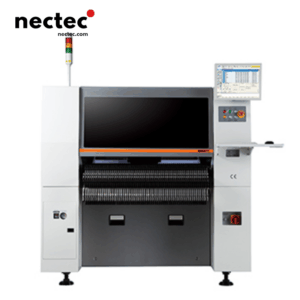The electronics manufacturing industry is continually evolving, driven by advancements in technology and the increasing demand for precision and efficiency. One of the key players in this evolution is the mașină SMT (Surface Mount Technology) de preluare și plasare. These machines have revolutionized the way electronic components are assembled, making the process faster, more reliable, and more cost-effective. In this blog post, we will delve into the latest innovations in pick and place SMT machines and their impact on the electronics manufacturing landscape.
Înțelegerea mașinilor SMT Pick and Place
At its core, a pick and place SMT machine automates the assembly of surface-mount devices (SMDs) onto printed circuit boards (PCBs). The machines use a combination of robotics and vision systems to accurately position components onto the PCB. This level of automation not only speeds up the process but also reduces human error, which is crucial in maintaining the quality and reliability of electronic products.
Cum funcționează mașinile Pick and Place
The basic operation of a pick and place machine involves several key steps:
- Identificarea componentei: Using advanced vision systems, the machine identifies and locates the components from the feeder trays.
- Picking: The robotic arm carefully picks the component from the feeder to avoid any damage.
- Plasament: The machine places the component on the PCB at the exact required position.
- Inspecție: Many modern machines incorporate inspection systems that allow for immediate verification of the component placement, ensuring high-quality output.
Innovations Transforming Pick and Place SMT Machines
As technology progresses, so does the efficiency and capability of pick and place SMT machines. Here are some of the top innovations shaping the future of these machines:
1. Sisteme avansate de vedere
Modern pick and place machines are now equipped with sophisticated vision systems that leverage artificial intelligence (AI) and machine learning algorithms. These enhancements allow machines to recognize a broader array of components and adapt to variations in component placement quickly. This adaptability minimizes the need for downtime during setup changes, making production runs more efficient and reducing costs.
2. Enhanced Speed and Throughput
As the demand for faster production cycles increases, manufacturers are turning to machines that can deliver higher speeds without sacrificing precision. Innovations in motor technology and control algorithms have led to pick and place machines capable of achieving speeds of up to 100,000 components per hour. This dramatic increase in throughput not only meets client demands but also maximizes profitability for manufacturers.
3. Proiectare modulară
Flexibility in production is important, especially for companies that handle a diverse range of products. Modular pick and place machines enable manufacturers to customize their machines based on specific production requirements. Components such as additional feeders, sensors, and vision systems can be added or removed easily, allowing businesses to scale their operations up or down as needed.
4. Integration of IoT and Industry 4.0
The integration of the Internet of Things (IoT) into pick and place machinery is fostering a new era of data-driven manufacturing. Smart machines can collect and transmit data in real-time, providing manufacturers with insights into production efficiency, machine health, and potential bottlenecks. This data enables predictive maintenance, reducing equipment downtime and extending machine lifespan.
The Benefits of Upgrading Pick and Place SMT Machines
Investing in advanced pick and place technology comes with a host of benefits:
- Eficiență crescută: With faster speeds and streamlined processes, manufacturers can produce more products in less time.
- Îmbunătățirea controlului calității: Enhanced inspection capabilities reduce the chances of defects and ensure high-quality assembly.
- Reducerea costurilor: While the initial investment may be higher, the long-term savings from reduced labor costs and increased throughput can be significant.
- Flexibilitate: Modular designs allow manufacturers to adapt to market changes and different product lines without significant overhaul costs.
Provocările cu care se confruntă industria SMT
While innovations in pick and place SMT machines are transforming the industry, several challenges remain. One major hurdle is the skilled labor shortage. As machines become more sophisticated, the need for skilled technicians to operate and maintain these systems increases. Additionally, as electronics become more complex, manufacturers must continually invest in training and development to keep pace with technological advancements.
Importanța învățării continue
To succeed in this dynamic environment, manufacturers must foster a culture of continuous learning. Training programs that focus on the latest technologies in SMT can ensure that workers are equipped with the necessary skills to operate advanced machines effectively. Moreover, establishing partnerships with educational institutions can help create a pipeline of skilled workers ready to enter the electronics manufacturing workforce.
Tendințe viitoare în fabricarea produselor electronice
Looking ahead, several trends are poised to shape the future of electronics manufacturing and pick and place SMT machines. These include:
- Automatizare și robotică: The move towards fully automated production lines is expected to accelerate, with robotics playing a crucial role in improving efficiency and accuracy.
- Sustenabilitate: As environmental concerns grow, manufacturers are increasingly focusing on sustainable practices, including energy-efficient machines and recyclable materials.
- Personalizare: The demand for personalized electronic products is rising. Future SMT machines may need to adapt to enable mass customization while remaining cost-effective.
In summary, innovations in pick and place SMT machines are vital to the future of electronics manufacturing. As technology continues to evolve, staying updated on these advancements will be crucial for manufacturers looking to remain competitive in an increasingly global market. Whether it is through improved efficiency, enhanced quality control, or the integration of IoT, the future of pick and place technology is indeed bright.






